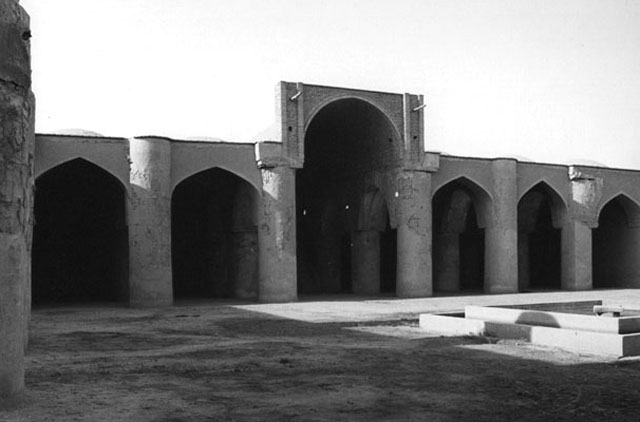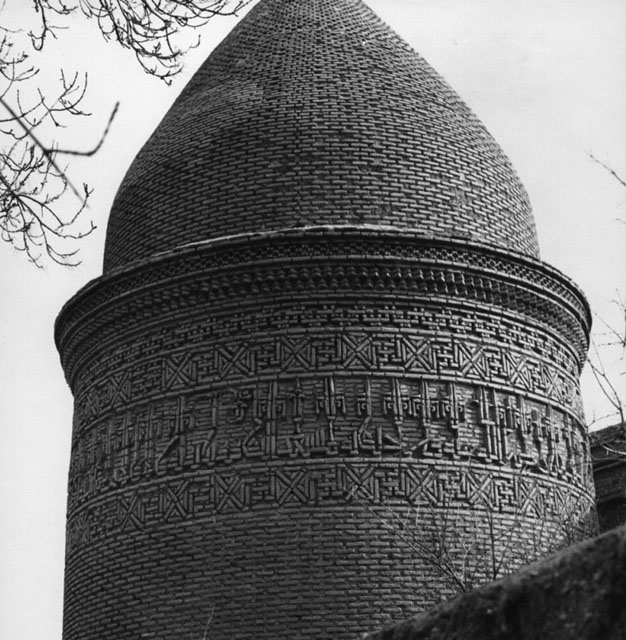An excerpt from the Safar-nama of Nasir Khusraw:
“On Friday the eighth of Dhul-Qada (May 17, 1046 CE) I went to Damghan. On the 1st of Dhul-Hijjah 437 AH (June 9, 1046 CE) I came to Simnan by way of Abkhawari and Chashtkhwaran …”
Source: Thackston, W. Wheeler McIntosh, ed. trans., Nasir- i Khusraw’s Book of Travels (Costa Mesa, CA: Mazda Publishers, 2010), 3.
Damghan, also known as Qumis or Shahr Qumis, is a town on the main highway and a station on the railway, between Tehran and Mashad. Damghan is among Persian cities that are rich in archaeological remains and monuments, ranging from 4th BCE to the 19th century. The town had perhaps been under tentative Arab control since 22 AH / 643 CE; however, a definitive Muslim rule was established there in 30 AH / 651-52 CE.
The development of Damghan into an urban centre is likely to have occurred when the congregational mosque known as the Tarik-khana was built there, probably around the middle of 2nd AH / 8th CE century. Nevertheless, it can be assumed that there were Zoroastrians in Damghan, as there were in neighbouring Bistam, at least until the 3rd AH / 9th CE century.
The city was devastated in 242 AH / 856 CE by a violent earthquake, which destroyed half the buildings causing wide-scale death and destruction. Damghan reached its zenith again in the first half of the 11th century, under the governorship of a Ziyarid (Muslim dynasty) general. In 434 AH / 1042-43 CE, the Seljuks divided their newly conquered territories and Damghan, Tabarestan and Gorgan were allotted to a cousin of Tughril (429-55 AH / 1038-63 CE), Qutulmush b. Esra’il.
After 474 AH / 1082 CE, Seljuk power in the region was challenged by the Ismailis, when the province of Qumis was visited by Hasan Sabbah. Hasan Sabbah succeeded in taking possession of the Gerdkuh fortress, 18 km west of Damghan. The Ismaili stronghold in the region remained for nearly 180 years until the end of 658 AH / 1260 CE as they stood fast against the invading Mongols.
In the 4th AH / 10th CE century, the majority of Damghanis were said to be Hanafi sunnis (followers of the Hanafi School of Jurisprudence). The town also contains one of the oldest Shi‘i Imamzadas (shrines) in the Persian-speaking world from that time. As Damghan was controlled by the Shi‘a Ziyarids, and was considerably influenced by the Isma‘ilis and the Shi‘a rulers of Mazandaran, it can safely be assumed that at least a substantial minority of the population was Shi‘a or sympathetic to Shi‘ism, perhaps following different interpretations of Shi‘i Islam.
Archaeology of Damghan: One kilometre to the south of the town of Damghan is the mount called Tappa Hisar where excavations conducted by the University of Pennsylvania in 1931 uncovered prehistoric burials and the plaster-decorated remains of a building of the Sasanid period. The oldest Muslim structure, possibly the earliest surviving mosque in Iran, is Masjid-i Tarik Khana believed to date from the 3rd AH / 9th CE century. Attached to this mosque is a minaret from 5th AH / 11th CE century. Several tomb-towers of the Seljuk period have also survived todate.
Citation:
"Damghan." Encyclopaedia of Islam, Second Edition. Brill Online, 2012. http://referenceworks.brillonline.com/entries/encyclopaedia-of-islam-2/damghan-SIM_1684 [accessed June 2013]
Daftary, Farhad. A short history of the Ismailis. (Princeton, NJ: M. Wiener, 1998).
“Damghan.” Encyclopeadia Iranica Online. 2011.
http://www.iranicaonline.org/articles/damgan-persian-town [accessed June 2013]
Hunsberger, Alice C. Nasir Khusraw, the ruby of Badakhshan. (London: I. B. Tauris, 2000).
Masjid-i Tarik Khana
http://www.archnet.org/sites/1605 [accessed February 2014]
Imamzade Ja'far and Muhammed
http://www.archnet.org/sites/4727 [accessed February 2014]
Gunbad-i Chihil Dukhtaran
http://www.archnet.org/sites/1601 [accessed February 2014]
More monuments in Damghan
http://www.archnet.org/sites/1601[accessed February 2014]


